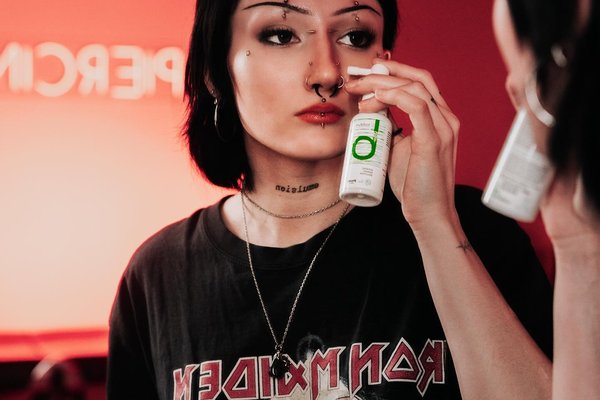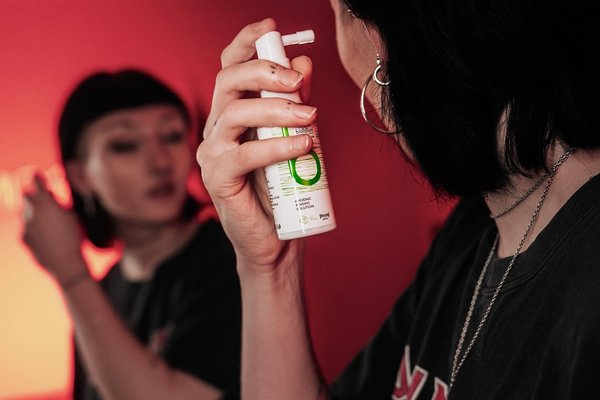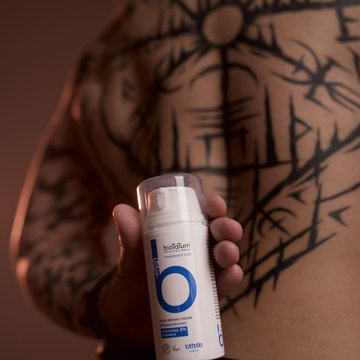The proper aftercare of piercings
For many years, piercings have been a popular way to decorate the body, especially among young people.
Both men and women can use a piercing to highlight their style and personality traits. Eyebrow, tongue, nose, and cheek piercings were and still are the most popular. To ensure that the piercing looks good and neat over time, it needs proper aftercare, especially during the first few weeks after getting pierced. Besides caring about how the piercing looks, don't forget that it can affect your health. Therefore, the aftercare is very simple, but it is important to perform it. If you follow all the recommendations carefully, the piercing will heal much faster, and there will be no complications or infections. For the first two weeks, you should clean the piercing site up to five times a day with an antiseptic. After two weeks, you only need to clean once a day, as long as the piercing site requires it. The most popular products for piercing aftercare are Miramistin or Octenisept - solutions that do not need to be diluted. For treating the piercing, take a cotton pad, moisten it with the solution, and apply it to the piercing site until the crust that has formed softens. When the crust softens, the earring should also be treated. It is best to apply the antiseptic directly to the piercing site, as this accelerates the healing process. No other solutions should be used, for example, alcohol, iodine, or peroxide.

What should you avoid
during the healing of the piercing
What restrictions to follow after getting a piercing:
- Do not smoke for two to three hours;
- Do not consume alcohol 24 hours before, on the same day, and 24 hours after;
- Until the piercing site is fully healed, do not visit a swimming pool, sauna, or bathhouse;
- Do not take hot baths or showers. Showering should be done at room temperature;
- Do not apply makeup to the pierced area (e.g., powder, foundation, lipstick, etc.);
- The earring should not be constantly touched or removed;
- Do not touch the pierced spot without washing your hands;
- The earring should be chosen in accordance with the type of piercing and should be comfortable;
- Ensure the pierced spot is sterile and clean, and that no pus or crusts form.
The piercing must receive aftercare every day. The quality of the aftercare also determines how well the piercing will heal. It's important to prevent inflammation, as this can lead to more serious complications. If inflammation does start to occur, never resort to self-treatment. First, contact the person who performed the piercing, who can advise you on what to do. Then, if necessary, also consult a doctor.


How long it takes for a
piercing site to heal depends on the location on the body.
Piercing sites on different parts of the body heal differently.
For example:
- The lobe heals in one to one and a half months;
- Ear cartilage - three to six months;
- Tongue - one and a half months;
- Septum - two months;
- On the lips - one to two months;
- Monroe piercing - two and a half months;
- Labret - from two to two and a half months;
- Bridge - two and a half months;
- On the eyebrows - two to two and a half months;
- Nostrils - from one and a half to two months;
- Navel - three to six months;
- Flat piercing - up to nine months;
- Microdermal - at least six to a maximum of nine months;
- Nipples - up to two and a half months;
- Clitoris - one to two months;
- Majora labia - at least three to a maximum of five months;
- Minora labia - one and a half months to a maximum of two and a half months.
Keep in mind that the first two to three days, any type of piercing can become red and swollen. Pus can also form. And that is normal. The formation of pus means that the healing process is taking place, which is necessary for a better and faster healing of the wound. If these signs occur, you should contact a doctor as soon as possible:
- The redness slowly fades;
- There is swelling around the piercing, or the piercing site has become hard;
- The piercing site is painful for a long time, or there is fever;
- If green or yellow discharge occurs.
In some cases, the above signs do not indicate an infection but merely irritation by certain substances causing it. These should be avoided, such as washing and cleaning agents and other substances.

What does rejection
of the piercing mean
It does happen that the body rejects an earring.
Rejection is often accompanied by pain. If no pain occurs, the following symptoms can help you understand that there is rejection:
- The piercing site becomes wider, there is transparent discharge;
- The piercing site itches, there is a rash developed;
- The earring is visible through the skin.
Usually, the body rejects the earring because of the alloy. It is possible to choose an earring made of a different material. But first, you should contact the person who did the piercing. They will be able to advise you on the cause of this.



To accelerate the
healing of a piercing
Piercing healing can take months, depending on the location on the body.
So, how can you speed up the process? A sea salt solution can help. To prepare it, first wash your hands well with antibacterial soap. Then use a cotton pad moistened with water to clean the earring. After that, dilute the sea salt in warm water and treat the piercing site with this solution. Sea salt accelerates the healing of the piercing site and reduces irritation and inflammation. Moreover, you should eat healthily (more fresh fruit or even take vitamin supplements). People with diabetes should keep their blood sugar levels under control so that the recovery process does not take too long. You can also supplement your body with zinc to speed up the healing process. Additionally, people with diabetes should not consume too many foods that contain vitamin C, as it thickens the blood, which slows down the healing of the piercing site.

What precautions
should you adhere to?
When caring for the piercing, you should take the following precautions:
- If the piercing is below the neck, you should avoid tight and coarse clothing. Also, choose clothing without a collar;
- Minimize physical activity;
- If the piercing is in the ear, avoid contact with mobile phones and hair to not touch the pierced spot and disrupt the healing process;
- If the piercing is on the face, it should not be covered with makeup;
- If the piercing is in the mouth, rinse your mouth after eating with Miramistin or a sea salt solution.
If the aftercare method is not suitable, you should consult a piercing specialist. They will advise you on what you can do differently. You can purchase aftercare products for the piercing at our studio.


 Create a sketch in the VEAN TATTOO AI generator
Create a sketch in the VEAN TATTOO AI generator




